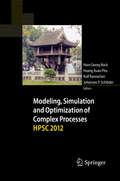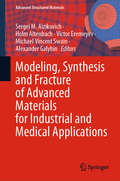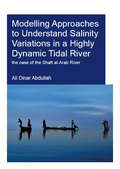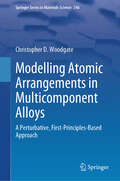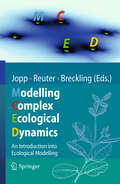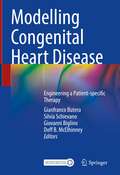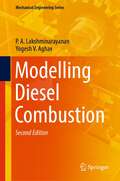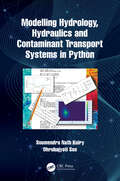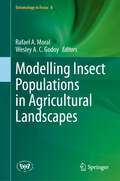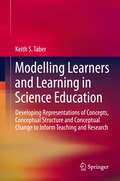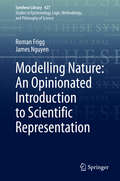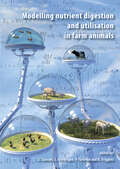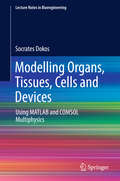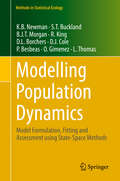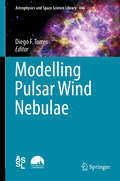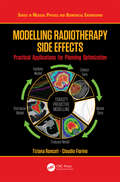- Table View
- List View
Modeling, Simulation and Optimization of Complex Processes - HPSC 2012
by Johannes P. Schlöder Rolf Rannacher Hans Georg Bock Xuan Phu HoangThis proceedings volume gathers a selection of papers presented at the Fifth International Conference on High Performance Scientific Computing, which took place in Hanoi on March 5-9, 2012. The conference was organized by the Institute of Mathematics of the Vietnam Academy of Science and Technology (VAST), the Interdisciplinary Center for Scientific Computing (IWR) of Heidelberg University, Ho Chi Minh City University of Technology, and the Vietnam Institute for Advanced Study in Mathematics. The contributions cover the broad interdisciplinary spectrum of scientific computing and present recent advances in theory, development of methods, and practical applications. Subjects covered include mathematical modeling; numerical simulation; methods for optimization and control; parallel computing; software development; and applications of scientific computing in physics, mechanics and biomechanics, material science, hydrology, chemistry, biology, biotechnology, medicine, sports, psychology, transport, logistics, communication networks, scheduling, industry, business and finance.
Modeling, Simulation, and Optimization of Supercritical and Subcritical Fluid Extraction Processes
by Zainuddin A. Manan Gholamreza Zahedi Ana Najwa MustapaThis book provides a complete guide on tools and techniques for modeling of supercritical and subcritical fluid extraction (SSFE) processes and phenomena. It provides details for SSFE from managing the experiments to modeling and optimization. It includes the fundamentals of SSFE as well as the necessary experimental techniques to validate the models. The optimization section includes the use of process simulators, conventional optimization techniques and state-of-the-art genetic algorithm methods. Numerous practical examples and case studies on the application of the modeling and optimization techniques on the SSFE processes are also provided. Detailed thermodynamic modeling with and without co-solvent and non equilibrium system modeling is another feature of the book.
Modeling, Synthesis and Fracture of Advanced Materials for Industrial and Medical Applications (Advanced Structured Materials #136)
by Holm Altenbach Victor Eremeyev Sergei M. Aizikovich Michael Vincent Swain Alexander GalybinThis book gathers papers presented at the international workshop PMSDAM’19. The respective contributions offer valuable insights for researchers working on numerical solutions to advanced materials problems. The problems concerning the remineralization of teeth are considered. Of particular interest are articles exploring topics at the interface of different disciplines.
Modellierung von Wasserrisiken: Entwicklung von Techniken zur Risiko-Rendite-Steuerung in der Finanzwelt und darüber hinaus
by Thomas Walker Dieter Gramlich Maya Michaeli Charlotte Esme FrankDieses Buch beleuchtet das Thema finanzielles Wasserrisiko, indem es die Modellierungs-Herausforderungen untersucht, die mit physischem, regulatorischem und Ruf-bedingtem Wasserrisiko in der Finanzwelt verbunden sind. Es erkundet verschiedene Ansätze zur Operationalisierung von Wasserrisiken aus finanzieller Analyse, Investmentmanagement und Klimawissenschaft. Die Analyse von Instrumenten zur Bewertung von Wasserrisiken bildet die Grundlage für die Entwicklung geeigneter Risiko-Rendite-Steuerungstechniken in der Finanzbranche und darüber hinaus. Dieses Buch liefert neue Einblicke, indem es sich auf finanzielle Wassergefahren und die damit verbundenen Chancen konzentriert. Es wird sowohl für Wissenschaftler als auch Praktiker von Interesse sein, die an der Schnittstelle von Finanzen, Wirtschaft, Natur und Gesellschaft tätig sind.
Modellierungsverfahren für die Konzeption von komplexen Systemen in der Fernsehproduktion: Operationalisierung des Systems Engineering für die digitale Transformation im Fernsehen
by Christiane JanuschDie Herstellungsprozesse in der Fernsehproduktion sind von einer unüberschaubaren Anzahl unterschiedlicher Varianten geprägt. Verschiedene Produktionsformen, wie beispielsweise die Aktualität, Live-Events oder Fiktionales Programm, erfordern ein vielfältiges Zusammenspiel der Funktionsbereiche eines Fernsehproduktionsunternehmens. Für die Optimierung der Herstellungsprozesse müssen redaktionell steuernde, administrativ begleitende und technisch ausführende Prozesse in übergreifend vernetzten, integrierten Produktionssystemen eng miteinander verknüpft werden. Vor dem Hintergrund dieser Komplexität bedarf es einer Gesamtsicht auf alle an der Produktion beteiligten Funktionsbereiche und deren Einbindung in den Herstellungsprozess. Es wird ein umfassendes Modellierungsverfahren vorgestellt, das in der Lage ist, sowohl die Gesamtbetrachtung zu fördern als auch Detailbetrachtungen vorzunehmen. Darüber hinaus wird die Anwendung der Methodik anhand von Praxisbeispielen erläutert. Es ist ein Vorschlag, den wissenschaftlichen Ansatz des Systems Engineering im Hinblick auf Problemstellungen in der Fernsehproduktion zu operationalisieren und den kontinuierlichen Optimierungsprozess zu unterstützen.
Modelling Approaches to Understand Salinity Variations in a Highly Dynamic Tidal River: The Case of the Shatt al-Arab River (IHE Delft PhD Thesis Series)
by Ali Dinar AbdullahThis book reports the first systematic monitoring and modelling study on water availability, water quality and seawater intrusion of the Shatt al-Arab River (SAR) on the border of Iraq and Iran, where causes and concentration levels of salinity have not yet been fully understood, let alone addressed, leading to conflicting perceptions of its origin (external or internal), the natural conditions and the practices that can explain the current critical conditions. Current scientific knowledge on the SAR salinity problem is deficient, partially due to the complex and dynamic interaction between marine and terrestrial salinity sources, including return flows by water users of the different water sectors in the Euphrates and Tigris rivers upstream of the SAR. The development of a new series of monitoring stations and various modelling approaches helped to better understand the interactions between these different sources. The comprehensive and detailed dataset formed the basis for a validated analytical model that can predict the extent of seawater relative to other salinity sources in an estuary, and for a hydrodynamic model that can predict salinity changes. The adaptability of the models to changing conditions makes them directly applicable by water managers. The procedure can be applied to other comparable systems.
Modelling Atomic Arrangements in Multicomponent Alloys: A Perturbative, First-Principles-Based Approach (Springer Series in Materials Science #346)
by Christopher D. WoodgateThis book provides a comprehensive overview of a computationally efficient approach for modelling the phase behaviour of multicomponent alloys from first principles, describing both short- and long-range atomic ordering tendencies. The study of multicomponent alloy systems, which combine three or more base elements in near-equal ratios, has garnered significant attention in materials science due to the potential for the creation of novel materials with superior properties for a variety of applications. High-entropy alloys, which contain four or more base elements, have emerged as a particularly fascinating subset of these systems, demonstrating extraordinary strength and fracture resistance, among other desirable properties. The book presents a novel modelling approach for studying the phase behaviour of these systems, which is based on a perturbative analysis of the internal energy of the disordered alloy as evaluated within the Korringa–Kohn–Rostoker (KKR) formulation of density functional theory (DFT), using the coherent potential approximation (CPA) to average over chemical disorder. Application of a Landau-type theory to an approximate form of the Gibbs free energy enables direct inference of chemical disorder/order transitions. In addition, the perturbative analysis facilitates extraction of atom-atom effective pair interactions for further atomistic simulations. The connection between the arrangement of atoms in a material and its magnetic properties is also studied. By outlining and applying the proposed modelling techniques to several systems of interest, this book serves as a valuable resource for materials scientists, physicists, and chemists alike, seeking to understand and develop new alloy systems with enhanced materials properties.
Modelling Complex Ecological Dynamics
by Donald Deangelis Hauke Reuter Broder Breckling Melanie Trexler Sven Erik Jørgensen Fred JoppModel development is of vital importance for understanding and management of ecological processes. Identifying the complex relationships between ecological patterns and processes is a crucial task. Ecological modelling--both qualitatively and quantitatively--plays a vital role in analysing ecological phenomena and for ecological theory. This textbook provides a unique overview of modelling approaches. Representing the state-of-the-art in modern ecology, it shows how to construct and work with various different model types. It introduces the background of each approach and its application in ecology. Differential equations, matrix approaches, individual-based models and many other relevant modelling techniques are explained and demonstrated with their use. The authors provide links to software tools and course materials. With chapters written by leading specialists, "Modelling Complex Ecological Dynamics" is an essential contribution to expand the qualification of students, teachers and scientists alike.
Modelling Congenital Heart Disease: Engineering a Patient-specific Therapy
by Gianfranco Butera Silvia Schievano Giovanni Biglino Doff B. McElhinneyThis book combines medicinal and engineering knowledge to present engineering modelling applications (mainly computational, but also experimental) in the context of facilitating a patient-centred approach to treating congenital heart disease (CHD). After introducing the basic concepts of engineering tools, it discusses modelling and the applications of engineering techniques (e.g. computational fluid dynamics, fluid-structure interaction, structural simulations, virtual surgery, advanced image analysis, 3D printing) in specific congenital heart diseases. It also offers a number of clinical case studies describing the applications in real-life clinical practice. The final section focuses on the importance of surgical training, counselling and patient communication. Considering the unique anatomical arrangement pre/post repair in CHD, as well as the different surgical strategy and device options (e.g. stents) for interventions, a patient-specific approach is certainly warranted in this area of medicine, and engineering is helping improve our understanding of individual patients and their particular anatomy and physiology. To reinforce the idea of a necessary dialogue between clinicians and engineers, this book has not only been edited by two cardiologists and two bioengineers, but each chapter has been written by a clinician and an engineer, incorporating both voices in the description of state-of-the-art models for different CHDs.
Modelling Diesel Combustion (Mechanical Engineering Series)
by P. A. Lakshminarayanan Yogesh V. AghavThis book comprehensively discusses diesel combustion phenomena like ignition delay, fuel-air mixing, rate of heat release, and emissions of smoke, particulate and nitric oxide. It enables quantitative evaluation of these important phenomena and parameters. Most importantly, it attempts to model them with constants that are independent of engine types and hence they could be applied by the engineers and researchers for a general engine. This book emphasizes the importance of the spray at the wall in precisely describing the heat release and emissions for most of the engines on and off-road. It gives models for heat release and emissions. Every model is thoroughly validated by detailed experiments using a broad range of engines. The book describes an elegant quasi-one-dimensional model for heat release in diesel engines with single as well as multiple injections. The book describes how the two aspects, namely, fuel injection rate and the diameter of the combustion bowl in the piston, have enabled meeting advanced emission, noise, and performance standards. The book also discusses the topics of computational fluid dynamics encompassing RANS and LES models of turbulence. Given the contents, this book will be useful for students, researchers and professionals working in the area of vehicle engineering and engine technology. This book will also be a good professional book for practising engineers in the field of combustion engines and automotive engineering.
Modelling Human-Flood Interactions: A Coupled Flood-Agent-Institution Modelling Framework for Long-Term Flood Risk Management (IHE Delft PhD Thesis Series)
by Yared Abayneh AbebeThe negative impacts of floods are attributed to the extent and magnitude of a flood hazard, and the vulnerability and exposure of natural and human elements. In flood risk management (FRM) studies, it is crucial to model the interaction between human and flood subsystems across multiple spatial, temporal and organizational scales. Models should address the heterogeneity that exists within the human subsystem, and incorporate institutions that shape the behaviour of individuals. Hence, the main objectives of the dissertation are to develop a modelling framework and a methodology to build holistic models for FRM, and to assess how coupled human-flood interaction models support FRM policy analysis and decision-making. To achieve the objectives, the study introduces the Coupled fLood-Agent-Institution Modelling framework (CLAIM). CLAIM integrates actors, institutions, the urban environment, hydrologic and hydrodynamic processes and external factors, which affect FRM activities. The framework draws on the complex system perspective and conceptualizes the interaction of floods, humans and their environment as drivers of flood hazard, vulnerability and exposure. The human and flood subsystems are modelled using agent-based models and hydrodynamic models, respectively. The two models are dynamically coupled to understand human-flood interactions and to investigate the effect of institutions on FRM policy analysis.
Modelling Hydrology, Hydraulics and Contaminant Transport Systems in Python
by Soumendra Nath Kuiry Dhrubajyoti SenThis book covers theoretical aspects of the physical processes, derivation of the governing equations and their solutions. It focusses on hydraulics, hydrology, and contaminant transport, including implementation of computer codes with practical examples. Python-based computer codes for all the solution approaches are provided for better understanding and easy implementation. The mathematical models are demonstrated through applications and the results are analyzed through data tables, plots, and comparison with analytical and experimental data. The concepts are used to solve practical applications like surface and ground water flow, flood routing, crop water requirement and irrigation scheduling. Combines the area of computational hydraulics, hydrology, and water resources engineering with Python Gives deep description of the basic equations and the numerical solutions of both 1D and 2D problems including the numerical codes Includes step-by-step translation of numerical algorithms in computer codes with focus on learners and practitioners Demonstration of theory, mathematical models through practical applications Analysis of each example through data tables, plots, and correlation with reality This book is aimed at senior undergraduates and graduate students in Civil Engineering, Coastal Engineering, Hydrology, and Water Resources Engineering.
Modelling Insect Populations in Agricultural Landscapes (Entomology in Focus #8)
by Rafael A. Moral Wesley A. C. GodoyThis book combines chapters emphasising mathematical, statistical, and computational modelling applied to insect populations, particularly pests or natural enemies in agricultural landscapes. There is a gap between agricultural pest experimentation and ecological theory, which requires a connection to supply models with laboratory, and field estimates and projects receiving inputs and insights from models. In addition, decision-making in entomology with respect to pest management and biological conservation of natural enemies has been supported by results obtained from different computational and mathematical approaches. This book brings contemporary issues related to optimization in spatially structured landscapes, insect movement, stability analysis, game theory, machine learning, computer vision, Bayesian modelling, as well as other frameworks.
Modelling Learners and Learning in Science Education
by Keith S. TaberThis book sets out the necessary processes and challenges involved in modeling student thinking, understanding and learning. The chapters look at the centrality of models for knowledge claims in science education and explore the modeling of mental processes, knowledge, cognitive development and conceptual learning. The conclusion outlines significant implications for science teachers and those researching in this field. This highly useful work provides models of scientific thinking from different field and analyses the processes by which we can arrive at claims about the minds of others. The author highlights the logical impossibility of ever knowing for sure what someone else knows, understands or thinks, and makes the case that researchers in science education need to be much more explicit about the extent to which research onto learners' ideas in science is necessarily a process of developing models. Through this book we learn that research reports should acknowledge the role of modeling and avoid making claims that are much less tentative than is justified as this can lead to misleading and sometimes contrary findings in the literature. In everyday life we commonly take it for granted that finding out what another knows or thinks is a relatively trivial or straightforward process. We come to take the 'mental register' (the way we talk about the 'contents' of minds) for granted and so teachers and researchers may readily underestimate the challenges involved in their work.
Modelling Metabolism with Mathematica
by Peter Mulquiney Philip W. KuchelWith the advent of sophisticated general programming environments like Mathematica, the task of developing new models of metabolism and visualizing their responses has become accessible to students of biochemistry and the life sciences in general. Modelling Metabolism with Mathematica presents the approaches, methods, tools, and algorithms for mode
Modelling Natural Action Selection
by Anil K. Seth Tony J. Prescott Joanna J. BrysonAction selection is the task of doing the right thing at the right time. It requires the assessment of available alternatives, executing those most appropriate, and resolving conflicts among competing goals and possibilities. Using advanced computational modelling, this book explores cutting-edge research into action selection in nature from a wide range of disciplines, from neuroscience to behavioural ecology, and even political science. It delivers new insights into both detailed and systems-level attributes of natural intelligence and demonstrates advances in methodological practice. Contributions from leading researchers cover issues including whether biological action selection is optimal, neural substrates for action selection in the vertebrate brain, perceptual selection in decision making, and interactions between group and individual action selection. This first integrated review of action selection in nature contains a balance of review and original research material, consolidating current knowledge into a valuable reference for researchers while illustrating potential paths for future studies.
Modelling Nature: An Opinionated Introduction to Scientific Representation (Synthese Library #427)
by Roman Frigg James NguyenThis monograph offers a critical introduction to current theories of how scientific models represent their target systems. Representation is important because it allows scientists to study a model to discover features of reality. The authors provide a map of the conceptual landscape surrounding the issue of scientific representation, arguing that it consists of multiple intertwined problems. They provide an encyclopaedic overview of existing attempts to answer these questions, and they assess their strengths and weaknesses. The book also presents a comprehensive statement of their alternative proposal, the DEKI account of representation, which they have developed over the last few years. They show how the account works in the case of material as well as non-material models; how it accommodates the use of mathematics in scientific modelling; and how it sheds light on the relation between representation in science and art. The issue of representation has generated a sizeable literature, which has been growing fast in particular over the last decade. This makes it hard for novices to get a handle on the topic because so far there is no book-length introduction that would guide them through the discussion. Likewise, researchers may require a comprehensive review that they can refer to for critical evaluations. This book meets the needs of both groups.
Modelling Nature: An introduction to mathematical modelling of natural systems
by Edward Gillman Michael GillmanThe use of mathematical models is a fundamental aspect of modern science. With computers now allowing previously difficult calculations to be done quickly and easily, an understanding of mathematics and an appreciation for modelling is possible even in fields with traditionally less mathematical content. Modelling Nature introduces basic concepts in mathematical modelling applied to natural systems to tackle real-world problems from fields such as physics, ecology, geology and epidemiology. It shows how using models can help to unravel complex issues such as the melting of the Arctic ice, the spread of infectious disease and the age of the Earth. The text helps students to build steadily upon a basic level of mathematics, to a more advanced understanding of mathematical concepts, for a thorough understanding of a variety of mathematical techniques. Key features include: Worked through calculations, with clear steps that can be followed with just a calculator, pen and paper or popular software packages. Intuitive introduction of advanced mathematical techniques in the context of model building, for an understanding of real-life application. An emphasis on an overall philosophy of building models, drawing repeatedly from the key elements of data, physical processes and mathematical methods to develop and refine models.
Modelling Nature: An introduction to mathematical modelling of natural systems
by Edward Gillman Michael GillmanThis short textbook introduces students to the concept of describing natural systems using mathematical models. We highlight the variety of ways in which natural systems lend themselves to mathematical description and the importance of models in revealing fundamental processes. The process of science via the building, testing and use of models (theories) is described and forms the structure of the book. The book covers a broad range from the molecular to ecosystems and whole-Earth phenomena. Themes running through the chapters include scale (temporal and spatial), change (linear and nonlinear), emergent phenomena and uncertainty. Mathematical descriptions are kept to a minimum and we illustrate mechanisms and results in graphical form wherever possible. Essential mathematical details are described fully, with the use of boxes. The mathematics supports but does not lead the text.
Modelling Non-Markovian Quantum Systems Using Tensor Networks (Springer Theses)
by Aidan StrathearnThis thesis presents a revolutionary technique for modelling the dynamics of a quantum system that is strongly coupled to its immediate environment. This is a challenging but timely problem. In particular it is relevant for modelling decoherence in devices such as quantum information processors, and how quantum information moves between spatially separated parts of a quantum system.The key feature of this work is a novel way to represent the dynamics of general open quantum systems as tensor networks, a result which has connections with the Feynman operator calculus and process tensor approaches to quantum mechanics. The tensor network methodology developed here has proven to be extremely powerful: For many situations it may be the most efficient way of calculating open quantum dynamics. This work is abounds with new ideas and invention, and is likely to have a very significant impact on future generations of physicists.
Modelling Nutrient Digestion and Utilisation in Farm Animals
by N. Friggens D. Sauvant P. Faverdin J. Van MilgenFor more than 30 years, modelling has been an important method for integrating, in a flexible, comprehensive and widely applicable way, basic knowledge and biological concepts on digestion and metabolism in farm animals. The purpose of this book is to present the 'state of art' in this area. The chapters are written by leading teams and researchers in this field of study, mainly from Europe, North America and Australasia. Considerable progress has been made in topics dealing with: modelling methods, feeding behaviour, digestion and metabolic processes in ruminants and monogastric animals. This progress is clearly illustrated by the emergence of a new paradigm in animal nutrition, which has moved from the aim to cover the requirements of the animal to explaining and predicting the responses of the animals to diets (e.g., productivity and efficiency, impact on quality of products, environmental aspects, health and well-being). In this book several chapters illustrate that through empirical models, meta-analysis is an efficient tool to synthesize information gathered over recent decades. In addition, compared with other books on modelling farm animal nutrition, two new aspects received particular attention: expanding knowledge of the individual animal to understanding the functioning and management of herds, and the consideration of the environmental impact of animal production. This book is a valuable source of information for researchers, nutritionists, advisors, and graduate students who want to have up-to-date and concise information on mathematical modelling applied to farm animals.
Modelling Organs, Tissues, Cells and Devices
by Socrates DokosThis book presents a theoretical and practical overview of computational modeling in bioengineering, focusing on a range of applications including electrical stimulation of neural and cardiac tissue, implantable drug delivery, cancer therapy, biomechanics, cardiovascular dynamics, as well as fluid-structure interaction for modelling of organs, tissues, cells and devices. It covers the basic principles of modeling and simulation with ordinary and partial differential equations using MATLAB and COMSOL Multiphysics numerical software. The target audience primarily comprises postgraduate students and researchers, but the book may also be beneficial for practitioners in the medical device industry.
Modelling Population Dynamics
by K. B. Newman S. T. Buckland B. J. T. Morgan R. King D. L. Borchers D. J. Cole P. Besbeas O. Gimenez L. ThomasThis book gives a unifying framework for estimating the abundance of open populations: populations subject to births, deaths and movement, given imperfect measurements or samples of the populations The focus is primarily on populations of vertebrates for which dynamics are typically modelled within the framework of an annual cycle, and for which stochastic variability in the demographic processes is usually modest. Discrete-time models are developed in which animals can be assigned to discrete states such as age class, gender, maturity, population (within a metapopulation), or species (for multi-species models). The book goes well beyond estimation of abundance, allowing inference on underlying population processes such as birth or recruitment, survival and movement. This requires the formulation and fitting of population dynamics models The resulting fitted models yield both estimates of abundance and estimates of parameters characterizing the underlying processes.
Modelling Pulsar Wind Nebulae
by Diego F. TorresIn view of the current and forthcoming observational data on pulsar wind nebulae, this book offers an assessment of the theoretical state of the art of modelling them. The expert authors also review the observational status of the field and provide an outlook for future developments. During the last few years, significant progress on the study of pulsar wind nebulae (PWNe) has been attained both from a theoretical and an observational perspective, perhaps focusing on the closest, more energetic, and best studied nebula: the Crab, which appears in the cover. Now, the number of TeV detected PWNe is similar to the number of characterized nebulae observed at other frequencies over decades of observations. And in just a few years, the Cherenkov Telescope Array will increase this number to several hundreds, actually providing an essentially complete account of TeV emitting PWNe in the Galaxy. At the other end of the multi-frequency spectrum, the SKA and its pathfinder instruments, will reveal thousands of new pulsars, and map in exquisite detail the radiation surrounding them for several hundreds of nebulae. By carefully reviewing the state of the art in pulsar nebula research this book prepares scientists and PhD students for future work and progress in the field.
Modelling Radiotherapy Side Effects: Practical Applications for Planning Optimisation (Series in Medical Physics and Biomedical Engineering)
by Tiziana Rancati Claudio FiorinoThe treatment of a patient with radiation therapy is planned to find the optimal way to treat a tumour while minimizing the dose received by the surrounding normal tissues. In order to better exploit the possibilities of this process, the availability of accurate and quantitative knowledge of the peculiar responses of the different tissues is of paramount importance. This book provides an invaluable tutorial for radiation oncologists, medical physicists, and dosimetrists involved in the planning optimization phase of treatment. It presents a practical, accessible, and comprehensive summary of the field’s current research and knowledge regarding the response of normal tissues to radiation. This is the first comprehensive attempt to do so since the publication of the QUANTEC guidelines in 2010. Features: Addresses the lack of systemization in the field, providing educational materials on predictive models, including methods, tools, and the evaluation of uncertainties Collects the combined effects of features, other than dose, in predicting the risk of toxicity in radiation therapy Edited by two leading experts in the field
